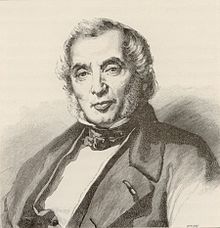Camille Pleyel
Joseph Etienne Camille Pleyel , also Joseph Stephan Camille Pleyel (born December 18, 1788 in Strasbourg , † May 4, 1855 in Montmorency near Paris ) was a French pianist , piano maker and music publisher.
Life
Pleyel was the youngest son from the marriage of the Austrian composer Ignaz Pleyel with the French Gabrielle Lefebvre. An encounter with Beethoven , whom he and his father visited in Vienna in the spring of 1805 , made a formative impression on Pleyel . He reported about this in several letters to his mother.
From 1815 he was a partner in his father's publishing house and the Pleyel piano factory . In 1831 he married the pianist Marie Moke , who had previously been in a relationship with Hector Berlioz .
Pleyel and his wife were among the closest friends of Frédéric Chopin , who dedicated the first edition of his 24 Preludes op.28 to him, including the famous Raindrop Prelude , which was written on Mallorca , where Chopin and George Sand embarked on November 7, 1838. Both lived there from December 15, 1838 in the Charterhouse of Valldemossa . The Preludes were commissioned by Pleyel, who also made sure that Chopin had a piano at his disposal on Mallorca, which did not arrive until January 1839. As early as January 22nd, 1839 he was able to inform Pleyel: “I am finally sending you my Preludes, which I finished on your piano, which had arrived in the best possible condition despite the sea, bad weather and customs from Palma .” The French first edition the Preludes appeared in Paris in autumn 1839. Chopin appeared several times on the premises (salons and Salle on) Pleyel, although he was little concerts.
Camille Pleyel's grave is in the Père Lachaise cemetery in Paris .
literature
- Alexander Rausch : Pleyel, brothers. In: Oesterreichisches Musiklexikon . Online edition, Vienna 2002 ff., ISBN 3-7001-3077-5 ; Print edition: Volume 4, Verlag der Österreichischen Akademie der Wissenschaften, Vienna 2005, ISBN 3-7001-3046-5 .
- Frédéric Chopin: Letters . Ed .: Krystyna Kobylańska. Berlin 1983.
- Jean-Jacques Trinques: Le piano Pleyel: d'un millénaire à l'autre . Paris 2003.
- Frédéric Chopin: Complete Preludes . Ed .: Norbert Müllemann. Henle-Verlag, Munich 2007.
- Jenny Kip: "More poetry than in ten Thalbergs". The pianist Marie Pleyel (1811–1875) . Oldenburg 2010.
- Christoph Kammertöns : Pleyel (family) and Pleyel & Co (piano making ) , in: Music in the past and present, personal part. Volume 13, edited by Ludwig Finscher . Bärenreiter, Kassel u. a. 2005, col. 689-696. ISBN 3-76181133-0 , ISBN 3-76181133-0
Individual evidence
- ↑ See Klaus Martin Kopitz , Rainer Cadenbach (Ed.) And a .: Beethoven from the point of view of his contemporaries in diaries, letters, poems and memories. Volume 2: Lachner - Zmeskall. Edited by the Beethoven Research Center at the Berlin University of the Arts. Henle, Munich 2009, ISBN 978-3-87328-120-2 , pp. 643-646.
| personal data | |
|---|---|
| SURNAME | Pleyel, Camille |
| ALTERNATIVE NAMES | Pleyel, Joseph Etienne Camille (full name); Pleyel, Joseph Stephan Camille (full name) |
| BRIEF DESCRIPTION | French pianist, piano maker, music publisher and owner of the largest Parisian concert hall |
| DATE OF BIRTH | December 18, 1788 |
| PLACE OF BIRTH | Strasbourg |
| DATE OF DEATH | May 4, 1855 |
| Place of death | Montmorency near Paris |
